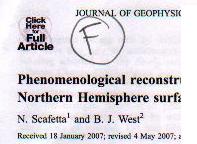Does climate sensitivity depend on the cause of the change?
Can a response to a forcing wait and then bounce up after a period of inertness?
Does the existence of an 11-year time-scale prove the existence of solar forcing?
Why does the amplitude of the secular response drop when a long-term trend is added?
[Read more…] about A phenomenological sequel
Spanish perspectives

The majority of the presentations focused on the science, but aspects such as the utility and the benefit of meteorology and climatology were also discussed. A media session also provided some thoughts about outreach and presented some examples of how weather is presented on TV. While gender and educational issues were discussed, the underrepresentation of other minorities was neglected.
Cosmic rays don’t die so easily

Furthermore, Svensmark and Friis-Christensen have written a response (title ‘Reply to Lockwood and Fröhlich – The persistent role of the Sun in climate forcing’; DNSC Scientific Report Series 3/2007) to a recent paper by Lockwood and Frohlich (LF2007). In this response, they state ’… [LF2007] argue that this historical link between the Sun and climate came to an end about 20 years ago‘. Another quote from their response is ‘Here we rebut their argument comprehensively’. So the cosmic ray theory isn’t quite dead after all?
Regional Climate Projections
Regional Climate Projections in the IPCC AR4

The climate projections presented in the IPCC AR4 are from the latest set of coordinated GCM simulations, archived at the Program for Climate Model Diagnosis and Intercomparison (PCMDI). This is the most important new information that AR4 contains concerning the future projections. These climate model simulations (the multi-model data set, or just ‘MMD’) are often referred to as the AR4 simulations, but they are now officially being referred to as CMIP3.
One of the most challenging and uncertain aspects of present-day climate research is associated with the prediction of a regional response to a global forcing. Although the science of regional climate projections has progressed significantly since last IPCC report, slight displacement in circulation characteristics, systematic errors in energy/moisture transport, coarse representation of ocean currents/processes, crude parameterisation of sub-grid- and land surface processes, and overly simplified topography used in present-day climate models, make accurate and detailed analysis difficult.
I think that the authors of chapter 11 over-all have done a very thorough job, although there are a few points which I believe could be improved. Chapter 11 of the IPCC AR4 working group I (WGI) divides the world into different continents or types of regions (e.g. ‘Small islands’ and ‘Polar regions’), and then discusses these separately. It provides a nice overview of the key climate characteristics for each region. Each section also provides a short round up of the evaluations of the performance of the climate models, discussing their weaknesses in terms of reproducing regional and local climate characteristics.
Transparency of the IPCC process
Recently, a Financial Times op-ed criticised the IPCC for having contributors and peers drawn from a narrow professional circle. I don’t think this is fair, unless one regards a whole discipline as ‘narrow’. Furthermore, recent public disclosure of both comments and response suggests a different story to the allegations in the FT op-ed of ‘refusing to disclose data and methods’. The IPCC has no control over the independent publication, but the disclosure of the comments and response at least enhances the openness for the synthesis of the report.
Why global climate models do not give a realistic description of the local climate
Global climate

Yet, whereas the global climate models (GCMs) tend to describe the global climate statistics reasonably well, they do not provide a representative description of the local climate. Regional climate models (RCMs) do a better job at representing climate on a smaller scale, but their spatial resolution is still fairly coarse compared to how the local climate may vary spatially in regions with complex terrain. This fact is not a general flaw of climate models, but just the climate models’ limitation. I will try to explain why this is below.
Does a Global Temperature Exist?
Does a global temperature exist? This is the question asked in a recently published article in Journal of Non-Equilibrium Thermodynamics by Christopher Essex, Ross McKitrick, and Bjarne Andresen. The paper argues that the global mean temperature is not physical, and that there may be many other ways of computing a mean which will give different trends.
The common arithmetic mean is just an estimate that provides a measure of the centre value of a batch of measurements (centre of a cloud of data points, and can be written more formally as the integral of x f(x) dx. The whole paper is irrelevant in the context of a climate change because it missed a very central point. CO2 affects all surface temperatures on Earth, and in order to improve the signal-to-noise ratio, an ordinary arithmetic mean will enhance the common signal in all the measurements and suppress the internal variations which are spatially incoherent (e.g. not caused by CO2 or other external forcings). Thus the choice may not need a physical justification, but is part of a scientific test which enables us to get a clearer ‘yes’ or ‘no’. One could choose to look at the global mean sea level instead, which does have a physical meaning because it represents an estimate for the volume of the water in the oceans, but the choice is not crucial as long as the indicator used really responds to the conditions under investigation. And the global mean temperature is indeed a function of the temperature over the whole planetary surface.
‘Cosmoclimatology’ – tired old arguments in new clothes

[Read more…] about ‘Cosmoclimatology’ – tired old arguments in new clothes
Climate Reporting in Physics World

What triggers ice ages?
by Rasmus Benestad, with contributions from Caspar & Eric
In a recent article in Climatic Change, D.G. Martinson and W.C. Pitman III discuss a new hypothesis explaining how the climate could change abruptly between ice ages and inter-glacial (warm) periods. They argue that the changes in Earth’s orbit around the Sun in isolation is not sufficient to explain the estimated high rate of change, and that there must be an amplifying feedback process kicking in. The necessity for a feedback is not new, as the Swedish Nobel Prize winner (Chemistry), Svante Arrhenius, suggested already in 1896 that CO2 could act as an amplification mechanism. In addition, there is the albedo feedback, where the amount of solar radiation that is reflected back into space, scales with the area of the ice- and snow-cover. And are clouds as well as other aspects playing a role.
